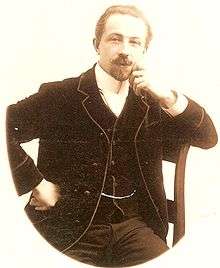Jan Frans De Boever

Jan Frans De Boever (Ghent, Belgium, 8 June 1872 - 23 May 1949) was a Flemish Symbolist painter. While considered a successful artist during most of his lifetime, his megalomaniac character made him a solitary and isolated individual.
Jan Frans De Boever received his training in Ghent at the Royal Academy of Fine Arts under Louis Tytgadt, whose niece he married.
Tytgadt provided him with an introduction to important artistic circles in his city, and he became a recognised celebrity at official exhibitions in Ghent, Antwerp, Brussels and Liège.
From 1909 onwards, he modified his style radically, painting women and prostitutes in morbid and bizarre settings, with skeletons, diabolism, subservient men and eroticism dominating his paintings. These paintings were allegorical and mythological, reflecting romantic imagery and depicting the universal struggle of good against evil.[1]
In 1914 he started to illustrate Charles Baudelaire's "Les Fleurs du mal" for the wealthy art-collector Speltinckx. Up to 1924 he made approximately 157 gouaches for the poems, though only 86 have been recovered.
Once he had discovered his own style, a form of Symbolism belonging to the decadent movement, he ignored ongoing artistic developments and drew his inspiration from literature, music and mythology. He was still inspired by patriotism, creating several paintings concerning the World Wars, displaying death and catastrophy in the Symbolist style.[2]
His paintings were very successful until 1935, when he suffered a financial crisis. He reduced his prices, and continued to paint in the same Symbolist fashion until his death in 1949.
References
- Achille Cavens "J.F. De Boever et son oeuvre" in "Les Débats" dd. 1.9.1931 p. 6.
- Roger De Buyst "Jan-Frans De Boever, leven en werk 1872-1949" Deurle 1984.
- Jan Boddaert, Roger De Buyst "Oeuvrecatalogus Jan Frans De Boever" Ghent 1993
- Jan Boddaert, Roger De Buyst "Jean François De Boever, sa vie et son oeuvre" Ghent 1996.
- Specific